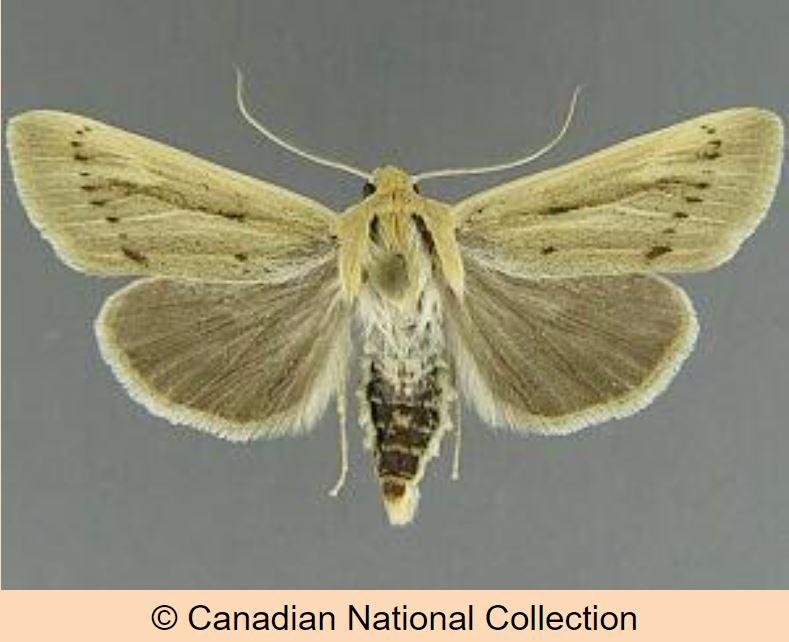Moderate
The population of the Copablepharon mutans moth in Washington is critical and is considered to have a declining trend. This moth is imperiled due to its rare habitat types, small number of isolated populations, extremely limited range, and known threats to its habitats. The species occupies open Columbia Basin sand dune habitats in eastern Washington.
Description and Range
Physical description
This Copablepharon moth is in the Family Noctuidae.
Ecology and life history
The Copablepharon mutans moth is one of three Copablepharon species described in 2004 in eastern Washington; the others are C. columbia and C. viridisparsa hopfingeri. All three moths inhabit small, geographically isolated sand dune complexes in the Columbia River Basin--rare ecological systems that are threatened by several factors. There has been little study of the biology and life history of these species. Host plants are not confirmed.
Copablepharon moths are habitat specialists that rely on loose, well-drained soils, especially sand. They are restricted to inland sand dunes in an arid shrubsteppe setting. The sands in all cases are glacially derived, and wind action provides soil disturbance that supports native vegetation. Beach and sand dune sites that have been stabilized from introduced plants or by other actions typically lose much of their native vegetation. These sand substrate habitats are rare in the Pacific Northwest.
Copablepharon moths complete a single life cycle annually (univoltine). They are sedentary, nocturnal moths that do not stray far from their restricted habitats and host plants. C. mutans adults are present in late August and early September.
Geographic range
The distribution of this species is limited by its dependence on rare and highly restricted ecological systems. C. mutans has been found in two sand dune areas along the Columbia River: near the Wanapum Dam (Grant County) and within the US Department of Energy Hanford site (Benton County).
Climate vulnerability
Sensitivity to climate change
Low-
Moderate
There is limited information on the sensitivity of Copablepharon mutans to climate change. Similar to Copablepharon columbia, it is likely sensitive to sand dune stabilization which typically leads to a loss of native vegetation and prevents formation of new dune areas. Sand dune stabilization is enhanced by high plant cover, which is facilitated during years of high precipitation and may also occur as a result of longer growing seasons due to climate change. Invasive species can also increase rates of dune stabilization. Drought may favor higher dune activity, which could enhance habitat quality and/or increase overall habitat for this moth, but could also impact its food plants (unknown at this time). For more information on habitat sensitivity, see Inter-Mountain Basins Active and Stabilized Dune habitat assessment.
Exposure to climate change
Moderate-
High
- Changes in precipitation and/or drought
- Increased invasive species
Conservation
Conservation Threats and Actions Needed
- Invasive and other problematic species
- Threat: Sand dune obligate: dunes are being stabilized by invasive plants, especially cheatgrass
- Action Needed: Eradicate cheatgrass and other invasive plants from dune systems
See the Climate vulnerability section for more information about the threats posed by climate change to this moth.
Resources
References
Hallock, L., R. Haugo, and R. Crawford. 2007. Conservation strategy for Washington inland sand dunes. WA Department of Natural Resources, Olympia. Natural Heritage Report 2007-05. https://www.fs.fed.us/r6/sfpnw/issssp/documents/planning-docs/cs-blm-wa-state-inland-sand-dunes-2007-06.pdf (PDF)
Lafontaine J. D., Crabo L. G., Fauske G. A. (2004) Genus Copablepharon. pp.146–180 in: Lafontaine (2004), Noctuoidea: Noctuidae (part) – Agrotini. In: Hodges RW (Ed.) The Moths of North America. Fascicle 27.1. The Wedge Entomological Research Foundation, Washington, 394 pp.
Pacific Northwest Moths. 2014. Western WA Univ. Bellingham. Available at: http://pnwmoths.biol.wwu.edu/
Other resources
- Xerces Society – Pollinator Conservation Program
- Xerces Society - Gardening for Moths
